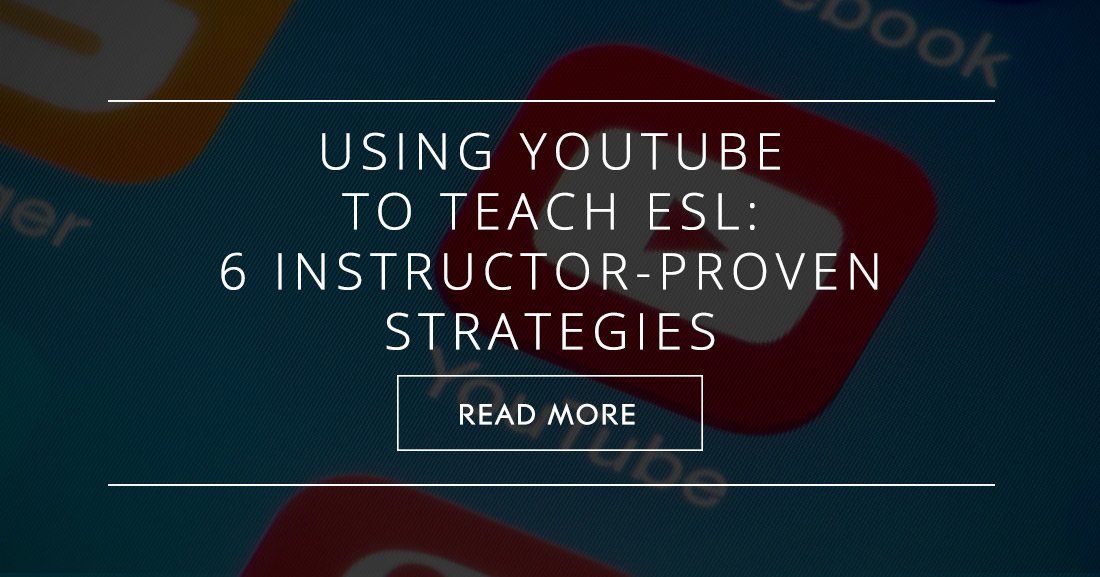Using YouTube to Teach ESL: 6 Instructor-Proven Strategies


There is just something about seeing lively characters on screen having fun and crazy adventures that appeals to the kid in all of us. And videos are a great resource for the ESL classroom. They give audio input while challenging and entertaining our students. But not every video is appropriate for the classroom. And even when you find good videos, it takes planning and intention to make the most use of them. After all, we are teachers above all, and we want out students to learn. Here are some tips to making the most of videos in class when you are teaching young learners.

If you are teaching young learners, anything you do will have to be short. Research shows that kids’ attention spans are approximately one minute for each year of age. That means a seven year old only has an attention span of seven minutes. Keep this in mind when choosing videos to use in your classroom. The younger your students, the shorter your videos should be. It’s okay if your video runs a bit longer than their natural attention span, but don’t push it too much. Shorter videos will also give students less information to digest all at once and will prevent them from getting overwhelmed easily. That’s not to say you can’t use longer videos at all. Just break them up into more manageable chunks rather than showing the entire thing at one time.
Nothing is as awful as planning on a video based lesson only to find you don’t have the technology to view it with your class. Adults may be flexible enough to grab their smartphones and link to a video you email them after a technical difficulty, but younger students won’t be so flexible. Before you plan on showing a video in class, double check your equipment. Do you have a TV or projector in your classroom? Do you have to reserve one? Do you have the cords you will need to connect the source device to the projector? Will you need something to block out light or increase the volume? Or will the equipment you already have be enough? It’s always a good idea to double check your setup before starting the lesson so you don’t waste valuable class time ironing out the little bugs in your technical equipment.
You could just play any video cold, but your viewing experience can be so much more effective if you prepare your students before they watch. Talk for a few minutes about the topic – what will happen in the video? What is it about? Introduce the characters, and ask your students if they know anyone like the characters they will see on the screen. Tell your students what problem the characters will face, and have your students predict how the characters will solve the problem. This will give your students a framework on which to build as they watch the video you have chosen.
One of many things kids are great at is going with the flow. Your students will not need to understand every word they will encounter in the video before you press play. In fact, even in their first languages young people are in the habit of determining meanings of unfamiliar words solely from their context. It’s their vocabulary super power. So before watching your video, give your students a heads up about vocabulary, but don’t make a big deal about it. Try giving them a short list of a few unfamiliar words they will hear in the video. Then as they watch, have students cross off each word as they hear it. After the video, ask students to guess the meaning of each word based on its context in the video. Then try giving them a list of definitions and having them match each word to the correct definition. Only then should you give the definition of each word and only if they need it. The more natural connections your students can make to new vocabulary words and the most they can understand those words with English definitions, the more it will benefit them in the long run.
Of course the whole point of showing videos in class is to further develop your students’ grasp on the English language, but that does not mean every activity has to be language based. Remember that all language students naturally understand more English than they are able to express, so be sensitive to this inequality with your follow-up activity. Instead of having students talk about the video right away, let them express their ideas without language first. The easiest way to do this is to have students draw a picture related to the video they just watched. Have them draw their favorite character in the video, and then ask students to draw a few small pictures under the character to represent what the character thinks about or the problems he or she faces in the video. Or you can have students fill in the frames of a blank comic strip retelling the story as it appeared in the video. These or other activities which do not require students to use English to express their ideas will help solidify what they watched in their minds and help them further understand the langue that was used in the video before they have to use it.
Just be intentional about the videos you choose and the way in which you use them. That way the experience is sure to be a positive one for both you and your students.